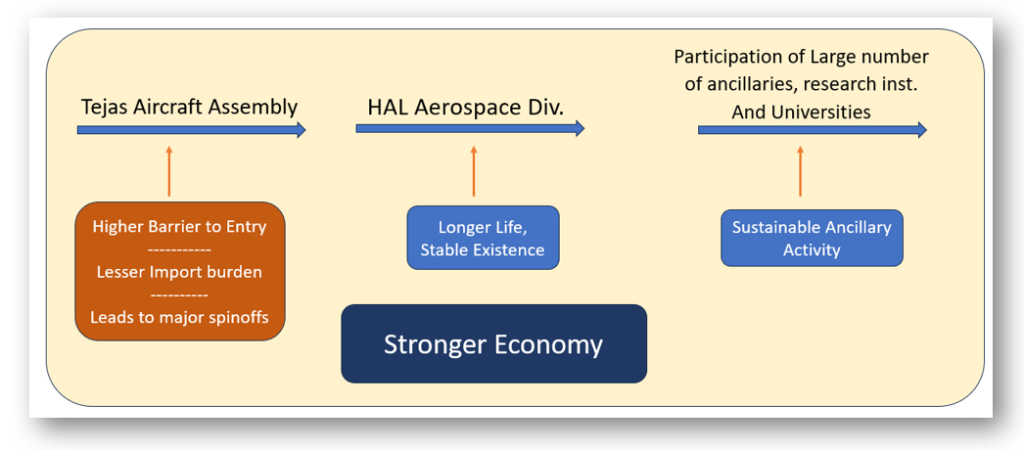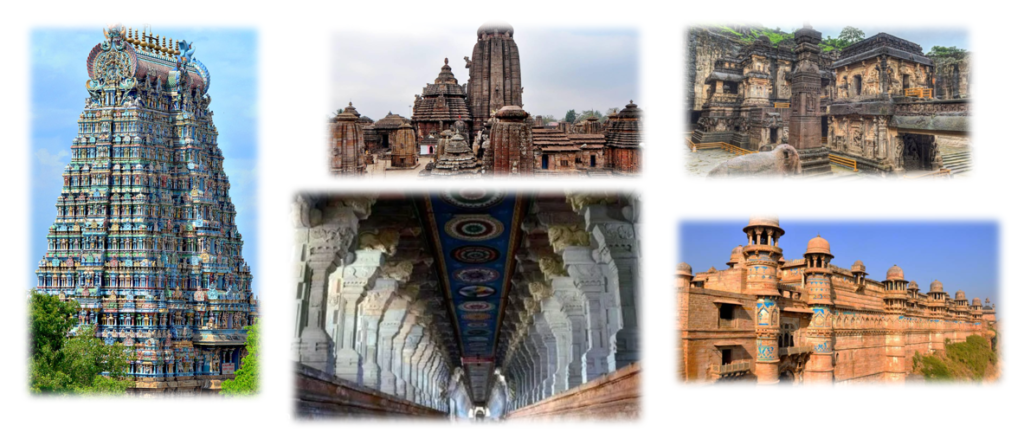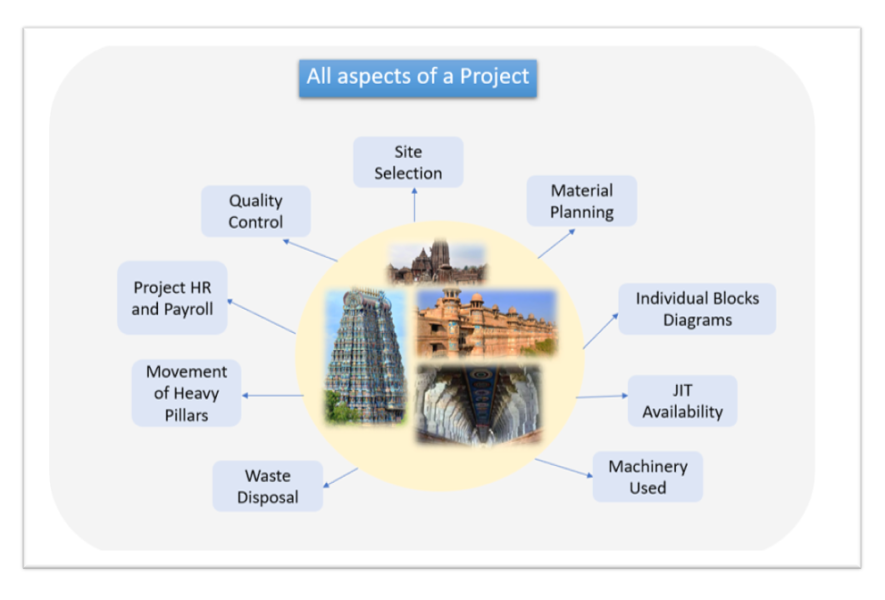Lord Rama is back to his birthplace in city of Ayodhya, UP, India.

No more staying in a Tent, as PM Modiji himself said!
It is also being said that with the consecration of Ram Lalla (Young Ram), “India that is Bharat” is making an umbilical connect, a civilizational connect with its past, going back to 1000’s of years.
It is hoped that with this hard-earned victory in the courts over those who denied that there was a temple before a structure was built, India’s citizens will be able to connect to its rich civilizational past and feel proud and not be apologetic, and signal to ourselves that we know how to take back what is ours.
The need for “India that is Bharat” to connect to its civilizational past has arisen partly due to the stark reality that neither Gandhiji’s pre Independence legacy nor post Independence legacy of leaders such as Nehru, Indira, and so on, have not been able to provide a platform for India to grow economically and provide a higher standard of living to its citizens. Our standard of living is a mixed bag, with some indicators doing well but what we see on the ground is not that inspiring.
The less said about spirit of creativity and innovation of the pre independence (mostly British and Mughal) legacies the better. We are an oppressed nation made to stay poor and work as labor for the rulers.
As of today, our Import dependence in the core areas is still high. An update on core sector production is available here.
The consequence is not just about precious foreign exchange, but also our bargaining power. When we do not have innovations in the core sector, we go to every bargaining table with nations as an underdog.

Take the case of Tejas Aircraft, which is manufactured in India, at HAL Aerospace Division. Tables have turned as regards India’s bargaining power, in this case. As we can sell this aircraft in the Light Fighter segment, to several countries, Engine Manufacturers are willing look at our terms a bit more favorably.

If we are able to design and build our own Jet Engines, the bargaining power will be much better.
This is the crux of the problem which is hindering India to quickly jump into the top 50 positions in the per capita income parameter. We are presently in 129th position out of 200 countries.
Which really means we have not been able to create a legacy of development which touches every citizen of the country. So, this quest for discovery of our past glory.
Let us look at this data:
Top 10 countries in Innovation infrastructure. Source: VisualCapital
- Switzerland
- USA
- Sweden
- UK
- Netherlands
- South Korea
- Singapore
- Germany
- Finland
- Denmark
India is not in the list. Every country, (except South Korea) listed above has a Per Capita Income which is above $50,000. Whereas, India has a Per Capita Income of $2.85. What this mean?
More people in these countries live reasonable well off. A low PCI shows more people live with lower standards living.
So, will Lord Ram provide us the legacy we need to grow as a technological super power driving economic growth leading to higher per capita income?
No, and PM Modi knows this.
Luckily for us, PM Modi has trusted his citizens and backed them in every step since the day he took over as CM of Gujarat. He has ensured that Indian’s realize that hard work can take us to a better life.
He and many of his ministers (I have no inside knowledge, but from what is visible to us) have cajoled and nudged us to work towards a coveted GDP Position in the world.
And, let us be clear it is not the Govt.’s job to be innovative and creative in Engineering.
At best Govt.’s can ensure create citizen friendly policy, its ministers and staff work hard and clear files asap, and keep the country secure.
However, all this will at best support growth but trigger growth which we need, to grow as a Technological Super Power or reach the promised Top 3 in GDP and retain the position, and to the more ambitious Top 10 in per capita income.
What we need is innovation and creativity. And, In scale.
If it is not the job of the Govt. to be creative and innovative, leading to startups, then whose job is it?
Obviously, it is the job of the citizens particularly the younger generation.
But, youngsters do not live in a vacuum. They live in an ecosystem, which includes family, friends, schools and colleges, and their own virtual world.
Schools and Colleges where youngsters spend most of their waking hours are the best places to initiate a trigger point for creativity and innovation. The solution proposed is designed to be introduced in these institutions. It is not intended to be the only solution, but this solution can be a source to set the Wings of Imagination on Fire.
After years of encouraging startup movements and various other initiatives in schools and colleges, with mixed results, the Govt. has realized something much more fundamental needs to be done on the creative and innovation front.
So, it has done what it knows best. Recently Govt. has set up a Re. 1 Lakh Crore Research Corpus fund to drive creativity and innovation.
This will help in a big way, but there is a missing piece of the puzzle.
Youngsters who are bristling with ideas of Innovation in Technology at the age of around 15-20 yrs. They are caught in the whirlpool of academic scores. Most of them are trained very well in recalling answers. Some of them learn how to find answers.
However, to train students to ask the “Right Question” which is the foundation for creating world class startups, the proposed solution can be the beginning platform.
Institutions can impart this learning to the students and provide academic training, and a startup incubator. Such, well trained youngsters will then be able take advantage of the support systems and innovation funds.
What we need to do is “Catch them Young”.
We need to catch our youngsters when in school and colleges and inject a sense of awe and astonishment about our “Engineering Civilizational Superiority”.
The proposed solution and initiative is called “Engineering Civilizational Connect”.
This is similar to “Cultural Civilizational Connect”, which we discussed earlier because this is what is missing and failed to blossom since the invasions started a 1000 years ago.
This initiative will clearly convey to India’s young that we were among the best in the world technologically many centuries ago and we need to catch up.
Briefly, this initiative is simple and ingenious, if I can say that.
It includes conducting theory and practical exercises for students of both high school and engineering colleges on the Engineering Challenges and how they were overcome to construct magnificent Temples, Palaces, and Forts of India.
The theory and practical exercises are designed to tickle the curiosity of youngsters and kindle a spirit of engineering enquiry into the construction projects of Temples, Palaces, Water Systems, Astronomical Instruments and Forts of India.
The underlying thrust of the entire exercise should be “Your ancestors did such wonderful projects, you better do bigger and smarter”. Big and Smart, Creative and Innovative should be the underlying theme of the exercise.
One cursory look at the large temples in India will tell us the projects were not small and simple but were large, complex and smart.

The number of temples which are really engineering marvels present all over India is an undeniable proof of our rich Engineering Civilization and was in a very advanced stage.
Why not leverage them to revive our “Engineering Civilizational Heritage”?
Let us explore what are the probable topics of discussion for triggering the innovation gene in our nation’s youngsters.
I am only considering Temples here. Similar format can designed for Water Systems, Astronomical Instruments, Metallurgy and Forts.
Topic #1: Site selection and Engineering Diagram
Site selection for temples and palaces by our ancestors has been impeccable and always near a water source such as a river or lake. Further, the ground is leveled so that logistics to temple or palace construction is easier.
Take the case of Mysore Palace. It is facing east, overseeing a lake (now dried) and if one comes out of the palace, Goddess Chamundeswari Temple on the mountains is visible. The Palace itself is on a vast land which is perfectly flat.
In the case of Tirupati Tirumala Devasthanam of Lord Venkateshwara, the temple complex is located on a large plot of flat land nestled amongst gigantic mountains.
Students should be taught the importance of selecting proper sites for construction of any structures which are designed for people to visit.

Topic #2: Material Planning
Material planning must have been a major task of temple, palace and fort construction. Just look at the variety of pillars manufactured, the size, dimensions, and meticulous planning that must have been practiced to ensure raw material of appropriate sizes is available to ensure temple construction went on without a hitch.
Topic #3: Individual blocks / parts Diagrams
In most of the temples and palaces, more than two pillars will not be of the same design. Each pillar drawings must have been drawn in sets and matched to other pillars in height and other dimensions, to ensure symmetry and aesthetics before beginning construction.
All such practical aspects of design construction should be highlighted.
Topic #4: JIT availability
Chiseling the pillars and carvings is a complicated task requiring variety of chisels, and other tools, grinding them periodically, consumables to lubricate, clean and polish.
All this requires JIT availability knowledge. Students can be given exercises to make them aware of all such as aspects related to work in progress.
Topic #5: Machinery used
Large machinery which could maintain alignment for long hours, maybe for days were most probably used for manufacturing the various parts, slabs and pillars.
For instance, pillars in Bellur Halebid temples in Karnataka, have grooves which are 10 appx. mm depth, and just a few mm thick.
You will find several of those in each pillar.
Students should be made aware of all the machinery which are a must to enable them appreciate India’s Engineering Civilization.
Topic #6: Waste disposal Procedures
Construction of such large temple structures must have created several tons of waste and debris. How were these handled and cleared and disposed off.
Students should be made of this topic as this is environmentally important.
Topic #7: Movement of heavy pillars and slabs
In today’s world we have cranes which make it possible to lift heavy material. But, in those days, 1000 years ago how were such finished products and raw material moved? How were they lifted, aligned and positioned and placed and sealed?
Topic #8: Project HR and skilled artisans
Such large and skilled construction projects require people with skills and project managers who can handle tasks handed over to them. Replacements must have been planned to ensure continuity of work.
Students should also be exposed to these aspects of Human Resources.
Topic #9: Payroll
The skilled people working on the construction projects must have been paid on a daily / weekly basis and on completion must have been rewarded also. What was the system then considering the time period.
Topic #10: Quality Control – Stages and Final
All the temple projects seem to have had quality control in stages and on completion. Temples and palaces are aesthetically beautiful and even today are pleasing to the eyes.
The above list is certainly not exhaustive. I have listed 10 and each institution can create its own list.
If you can think of some topics and suggestions do write and contribute in the comment section below.
We can also create a common central repository database, like a wiki with each institutions contribution recorded.
These topics can be introduced in stages and covered over a period of 3-5 years making it visually appealing and involving calculations, diagrams, project site visit, presentations and videos.
This will serve two purposes, one, connect with our rich engineering past and two, show our youngsters the advanced level of Engineering some hundreds of years ago.
My suggestion is to expose students in schools and colleges to these exercises before they start their career specific academic pursuits and importantly as they start seeing that most of the core parts IP sold in India today is held by a foreign company.
This exercise will create a mindset in young students that we were the best in Engineers in the world and let me also do something to regain our glorious Engineering past.
The thrust of the entire exercise is to convey to people at large that we consistently undertook large scale projects hundreds of years ago, our engineering marvels were not some freak constructions, but which required a big mandate, meticulous planning and execution, which used technology and with high finish quality and aesthetics.
When we introduce these topics in a structured fashion to students in the education curriculum, it acquires a sanctity and brings in seriousness about India’s Engineering Excellence history.
Foundation for Startups
This exercise will serve as an excellent foundation for startups as students will come terms such as finance, drawings, planning, execution, compliance in a simple and interesting environment.
This stakeholders for this initiative are:
Govt. of India
The Govt. as the custodian of all Indians has vital interest in boosting Engineering creativity and innovation. For India to break into the top 3 GDP nation, creativity and innovation based entrepreneurship infrastructure has to be created and this exercise can serve as a solid, easily implementable initiative.
So, the Govt. is the primary and major stakeholder.
Citizens
Being a citizen of a country where the GDP is high and per capita income is also high, is a blessing. Every citizen aims to increase their income and an ecosystem of creativity and innovation is the best bet to achieve this.
Citizens are the next biggest stakeholders
Youth
The future jobs are going to be creative and innovation because repetitive and mundane jobs will be done by Robots, Cobots and AI. They have to be hands on from a very young age, explore various options as careers and this exercise will make them aware of the how it is to create creative and innovative projects.
Engineering Colleges
Engineering Colleges have traditionally oriented themselves to become placement colleges and ensure their students get jobs.
However, with the advent of Robots, Cobots and AI, the placement scenario is changing fast. Colleges have to brace themselves to train students to be creative and innovative, to manufacture products and provide services.

This will be an excellent precursor to the Startup Incubator in your College where you offer Pre Incubation and Incubation services at a fee for students.
Note:
If you conduct this initiative in your college/department, please let us know and we will help publicize your college/department to 1 (One) Crore (100 Lakhs) on our high traffic website, email to targeted HNIs, Education Ministry Officials, Engineering associations and Professionals.
All you need to do is:
- Have a webpage on your department website about this initiative and progress and insights will pictures and updates
- Inform us of the URL of the page
That’s it. Your college will get free publicity and exposure to 1 (One) Crore (100 Lakhs) people. Absolutely FREE!
Next, let us see, why should we consider temples as the means for engineering civilizational connect with our past?
Reason #1: Temples are Sacred places, preserving our age old traditions and engineering talent. It is set to remain same for ages to come. So, any effort with temples as the core subject will stay on for hundreds of years.
Importantly, youngsters need to associate creativity and innovation as integral to our lives and as sacred, rather than as a separate subject or job. Our ancestors considered creativity and innovation as sacred and left us a great legacy.
Reason #2: Temples are living evidences of our centuries old world class Engineering. Every temple has its own engineering history to tell. All we need is the interest to stop and listen.
Reason #3: Temples with high value engineering are located all our India giving access to all students. This is important as, having two or three temples in the country would not have served the 2000+ Engineering Colleges in India.
Why is connecting with Engineering Civilization of India important?
Reason #1: For economy to grow rapidly Engineering has to be thriving and is the backbone. Engineering is the backbone of every industry out there.
Reason #2: Youngsters quickly relate to visible and obvious. We have few or no alternatives which are ready visible projects which link us to our top grade engineering history.
Reason #3: People’s connect with Temples is strong and unbreakable. Every week many parents take their children to temples near their homes. For us Temples are sacred to be preserved and cherished. When we associate creativity and innovation to sacred temples, children take to it in the right spirit.
Booklets titled “Engineering of Temple Construction” can also be given in local languages at the temple sites.
Leverages Temples, Water Systems, Astronomical Instruments, Palaces and Forts which our ancestors built with care and hard work, as models for Engineering Civilization Connect embeds an essential aspect of fostering Creativity and Innovation in the youth of our society. Which is, Creativity and Innovation as a way of Life and not a separate subject or a job.
When students are exposed to the topics mentioned above in their classes and projects, and they visit temples and other above mentioned sites along with their family they develop a sense of awe and appreciation of the massive effort which has gone into constructing these structures.
This appreciation can convert to a sense of pride and an effort to better our ancestors who built these structures.
Counter Arguments
I do realize that Temples are religion specific and some questions may arise which I have addressed below:
Isn’t this exercise not forcing students of other religions?
It is not. The reason is we do not bring in the aspect of God, Worship, Beliefs in the discourse anywhere.
Students from other religions can take up Water Systems, Astronomical Instruments, Forts, and Palaces.
A new subject has to be created. Will this not be an additional burden to students?
No. These topics and exercises can be included in the subject “History and Geography”.
Further, these chapters can be increased in content in higher grades.
Will these topics have academic depth?
Yes. Let me give an example.
The pillars of Bellur Halebid, are nearly 1.5 ft in diameter and 10 ft in height. They seem to be perfectly concentric, have grooves which are symmetric and all dimensions within certain tolerance.
So, for perfect alignment the pillars must have been mounted on centres. It is not possible otherwise. The question arises, the size of machinery required to mount 9ft by 1.5ft diameter stone pillars.

The size of the centers must have been massive to withstand weight of such large pillars.
Another question arises, the levelling of the ground on which the machinery were mounted, must have been perfectly horizontal.
Further, how were the pillars rotated to cut the grooves and shapes. Slow speed (rpm) will not work. A certain rotational speed must have been provided.
If this single example can fascinate you and me, imagine how an youngster will react to such questions.
They will also simultaneously realize, to be remembered you have to do something remarkable on such a scale. Only academic score will not suffice.
Take the example of Thanjavur temple
You will notice the huge block which are used to build the structure. Many people say elephants were deployed to lift the blocks. Maybe true, partly. Look deeper and we realize that blocks were placed one on top of the other at a appreciable height which required a complex set of pulleys which and braking systems.

There are such countless “Engineering Thought” provoking instances in all major temples, palaces and forts of India.
The way forward
As this is an academic exercise involving only engineering, without any other (political, social, religious) shades to it, the Govt. of the day, will extend support to institutions such as Engineering Colleges and High Schools who would like to start this initiative by providing funds for conducting workshops, seminars, site visits as part of this exercise.
Institutions will benefit individually, so they can take up the initiative on their own and include it as a part of their startup incubator activity. This initiative can be implemented much before the pre-incubation stage.
Doing a pilot project and showcasing it to request for support and funds from the Govt. may be the right way forward.
The Superstition Deterrent
Over the years the Hindu society has been hijacked by quacks in the garb of Astrologers, Pravachakartas and Swamijis.
These people feed on the human weakness of desire to control the unknown.
This has somehow made its way into Hinduism which has weakened the essence and principles of Santana Dharma and become a very integral part of daily life of a vast majority of Hindu families.
Let us look at some of the weird and unscientific superstition peddlers in today’s Hindu society.
This gentleman’s name is Shri. Chiluku Uday Bhaskar. The man uses a flexible plastic (looks like) stick which he calls mantra dandam, predicts election results and personal events.
The next gentleman’s name is Shri. Venu Swamy.
He uses astrology to predict personal events of politicians and film stars and VIP celebrities. He is also famous for using Liquor and Meat in his religious cermonies.
There are more subtle superstition promoters like Shri. Chaganti Koteswara Rao, and Shri. Sadhguru and ashrams like Ramachandra Mission who essentially mix religion and superstition and meditation in different proportions and promote their services.

I have no personal grouse against these people – when there is a market there is a seller.
However, I am worried about the impact on children and youngsters.
Imagine an youngster who believes he can control the unknown with getting an astrologer read his birth chart and advice on the God he has to pray to overcome a perceived dosha!
See the complete mixing of religion and superstition. This mixing gives credibility and societal sanction to superstition promoters, who feed on human insecurity and a desire to control the unknown. Unknown to us, the sober and sedate skills and Engineering promoting Hinduism is promoting superstition and blind beliefs.
Does the present political leadership at the center promote superstition and blind belief?
For a casual observer it might appear that the present dispensation believes in superstition.
Look closely there is no instance of the central govt. supporting superstition.
In fact, there is a clear instance of Shri. Amit Shah supporting “no belief” in superstition. To explain I have to introduce, Shri. Garikapati Narasimha Rao, Padma Shri. awardee and an Sahasra Avadhani.

He has in an interview specifically mentioned that the Govt. recognizes his efforts to educate people to not believe in superstition – in a letter addressed to him.
Many people may not know that there was a Department of Science in the Govt. of Andhra Pradesh back in 1990’s which had eradication of Superstition as one of its main Objectives!
So, what is the impact of blind beliefs and superstition on the human mind?
The most debilitating effect of Superstition on young minds is it discourages Critical Thinking as it encourages beliefs without questioning the logic of those beliefs. Coupled with the thought that something is destined and solution is in a religious ceremony encourages youngsters to inaction.
So, decoupling religion with superstition is of utmost importance. And, engaging youngsters with the marvelous engineering of religious places leads to a educated and civilized society.
What can I do?
This question may have come up in your mind as you read the article.
It is important to note that large temple, complex in structure, centuries old with a bit of recorded history is taken as a project so as to install awe and astonishment in minds of young children and young students.
If you are a citizen of this country and want to see the future generations lead a happy life do share this page with your friends and relatives and ask them ponder on this.
If you have children from 5th Grade to 10th Grade, you can take your children to a temple which is at least a couple of centuries old and together you can draw a diagram of the temple structure, note the dimensions if possible, highlight some salient points, and create a video explaining the salient points. Leave the child to its imagination, make them ask questions and try to find answers together.
If you are associated with a school, do include this project for your students and let them have a good experience of creativity and innovation practiced by our ancestors centuries ago.
If you are a Professor in an Engineering College, you can try and conduct a more detailed exercise with the involvement of Civil Engineering department and History department of an institution. If you undertake this exercise in your institution please do let us know and we will publicize the initiative free of cost.
Contemporary Relevance
While construction of structures has advanced tremendously, the principles enunciated and practiced when the ancient structures were constructed are relevant even today.
- Air Circulation
- Allowing Sunlight
- Water Logging
- Shelter in Case of Natural Disasters
- Tall Structures withstand several earthquakes over hundreds of centuries
- Aesthetics incorporated into the structures
General Guidelines for Conducting the Exercise
- Encourage students to use a slide based project report
- Encourage students to create a video of final report highlighting the engineering aspects only
- Arrange a field visit for students
- Provide students with printed material giving a brief background of temples, forts, water systems and astronomical instruments
- Do not bring in religion into the discourse
- Encourage students of other religions to take projects of their choice
Suggestions
Some suggestions in the process of implementing the solution.
- Institutions should create their own individual learning and format for conducting the exercise based on their students profile,
- Make it an institution wide Exercise
- Consider roping in a ASI (Archeological Survey of India) expert to provide inputs
- Encourage Students to come up with Ideas to create new exercises
- Document the Exercise from Day 1
- Make Creativity and Innovation as the thrust of the entire exercise
Conclusion
In this article, I have suggested a solution to inculcate a sense of pride in our students, by leveraging by leveraging living evidences of ambitious standards set and achieved by our ancestors, providing students with a basic set of material and creating slide based and video based project reports.
For India to reach the 3rd spot in GDP, and sustain the achievement, creativity and innovation is a must in Core sectors such as semi conductors, harnessing solar energy, engine manufacturing, highly secretive metallurgy, commercial airline manufacturing, micro surgery.
While the World looks at India as a huge market, we Indians should look at the whole world as a market.
For this to happen, connecting with our Engineering Civilization and regaining a sense of pride about our Engineering past is the first step.
Do not forget to share this article with your colleagues and friends. Log in to Comment your support and opinions.



